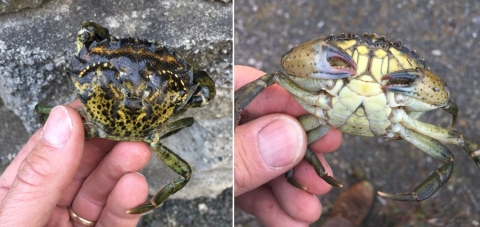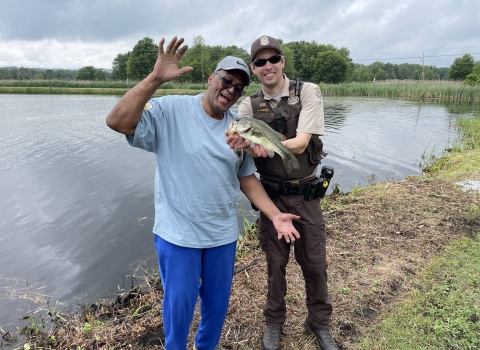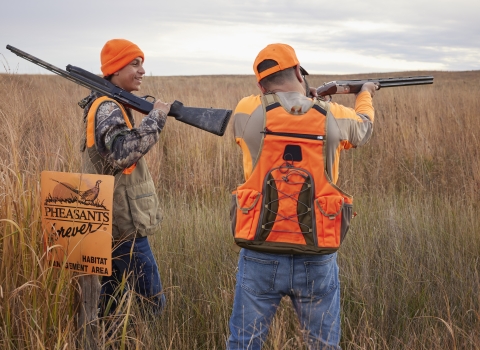It can sometimes be tough being the little guy. The younger and significantly smaller mature coho salmon males that return to our Pacific Northwest rivers, commonly known as jacks, often get a bad rap. I mean, who wouldn’t rather harvest their older counterparts that can be over ten times their size? However, the Quilcene National Fish Hatchery and their partners find value in these often underappreciated fish, in more ways than one. From their genetic worth, to tackling invasive species invasive species
An invasive species is any plant or animal that has spread or been introduced into a new area where they are, or could, cause harm to the environment, economy, or human, animal, or plant health. Their unwelcome presence can destroy ecosystems and cost millions of dollars.
Learn more about invasive species , to contributing to the rehabilitation of injured wildlife — these jacks pack a big supporting punch!
For those who don’t know jack about jacks, most coho salmon spend roughly their first 18 months in freshwater, followed by about 18 months at sea. This time feeding in salt water allows them to grow rapidly, develop their reproductive organs, and put on enough fat to fuel their freshwater journey back to their home stream and spawn (reproduce). However, some coho spend only about 6 months in salt water before returning to fresh. These younger and smaller coho are overwhelmingly male, hence the nickname “jack”. ”Jane” coho are incredibly rare because females require roughly 18 months in salt water to fatten up and develop their full amount of eggs, which average around 2,500 per fish.
These smaller coho jacks have no luck attracting females or competing with the larger 3-year-old males for dominance. Yet they don’t get all jacked up over the competition and are still able to fertilize some eggs; in some cases a lot of eggs! Jacks use what’s known as the “sneaking technique.” They simply hang back at a safe distance, “sneak” up to a spawning pair and fertilize eggs when the time is right, then swim out of Dodge before the unsuspecting male can retaliate.
And it’s a good thing jacks have some level of success. If every adult coho returned home as 3-year-old fish, they would be genetically isolated from the coho that spawn during the other 2 years of their life cycle. This hypothetical scenario, with three time-separated genetic populations, would lead to more inbreeding. Talk to anyone who breeds animals, and they will tell you that’s not a good thing. To put it short, coho jacks are the genetic bridge between spawning years. Maximizing genetic diversity is why Quilcene National Fish Hatchery spawns a percentage of coho jacks as recommended by conservation geneticists at Abernathy Fish Technology Center.
Another variable in the jack equation is what to do with their carcasses. Thousands of coho return to Quilcene National Fish Hatchery each year and all Pacific salmon die after spawning. That’s a lot of carcasses to handle and the hatchery does a great job at finding appropriate uses for all of them. About 2,000 coho are used for spawning, leaving both the post-spawned and non-spawned fish carcasses to be “excessed” for other uses. Larger 3-year-old coho are taken by our Tribal partners for cultural use, with the remaining donated to area food banks through a partnership with Northwest Harvest. While Jacks are not valued for these options, this does not stop Quilcene National Fish Hatchery from putting these fish to good use.
One of the superpowers of coho jacks is their contribution to combatting invasive species. Coho jack carcasses are an excellent bait for trapping European green crabs. These non-native crabs are a scourge in our western Washington waters as they compete with young Dungeness crab for food and habitat. They also eat young shellfish and damage eel grass beds, which is important habitat for herring and young salmon. The Dungeness National Wildlife Refuge has been monitoring for these crabs since 2000. Trapping occurred only once a month for the first several years, so finding bait was not a challenge. This all changed when the first European green crab was discovered on the Refuge in 2017.
Since 2017, there have been over 12,000 traps set! Currently, a team of around 30 volunteers baits and monitors approximately 800 traps from April 1st through September 30th, with re-baiting twice a week. That adds up to a lot of bait, which is where the jacks come in for the rescue.
“Having support from Quilcene National Fish Hatchery has been instrumental,” says Assistant Refuge Manager Lorenz Sollmann. “They have provided high quality and consistent coho salmon jacks for trap bait over the past several years. Our budget is very limited for this volunteer supported effort, so having access to this bait at no cost has also been extremely helpful.”
It is impossible to permanently eradicate European green crabs from the Refuge because their larvae drift into refuge waters through the currents from other areas. But each crab they remove helps prevent them from establishing a local reproducing population, particularly females, who can lay up to 250,000 eggs each, and over multiple times in their lifespan!
Jacks also have the power to aid in native wildlife rehabilitation. Since 2016, the Quilcene National Fish Hatchery has provided surplus coho jacks to West Sound Wildlife Shelter, which has operated in the Puget Sound region for over 30 years.
“With over 1,600 patients annually, the shelter creates specific medical care and meal plans for each type of species that comes through their doors,” says executive director, Lisa Horn. “As you can imagine, 1,600-plus patients whose average stay is 4 weeks, equals a lot of food. This year alone, the shelter has treated 14 bald eagles, which have consumed over 558 pounds of salmon!”
Many other animals benefit from this salmon nutrition at West Sound Wildlife Shelter as well. With feed representing a significant expense for wildlife rehabilitation, the cost of salmon is no longer a worry.
“The Shelter cannot thank the Quilcene Hatchery and the associated Tribes enough for this valuable gift of salmon,” says Horn. “This extraordinary partnership and the valuable friendships that have formed are making a far-reaching difference in the lives of wildlife patients in need and the wildlife rehabilitators who work tirelessly to return these animals to the wild.”
It is clear there is more than meets the eye when it comes to these undersized and generally underappreciated coho salmon. Though typically shunned by sport, subsistence, and commercial fishers, their genetic contributions and calorie value for other species and efforts cannot be overstated. Quilcene National Fish Hatchery is certainly thankful to have them and to share the bounty for other worthy efforts.







